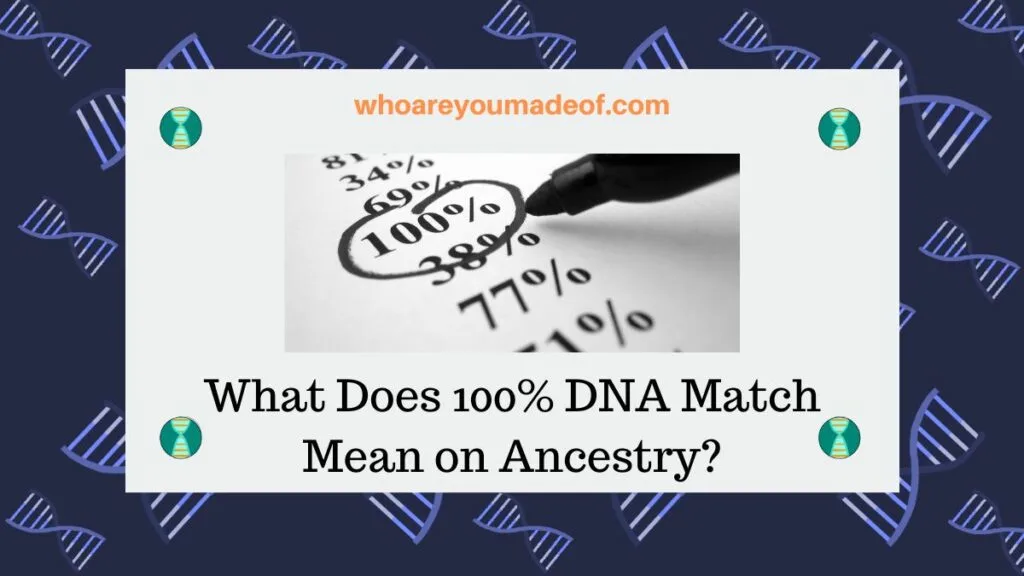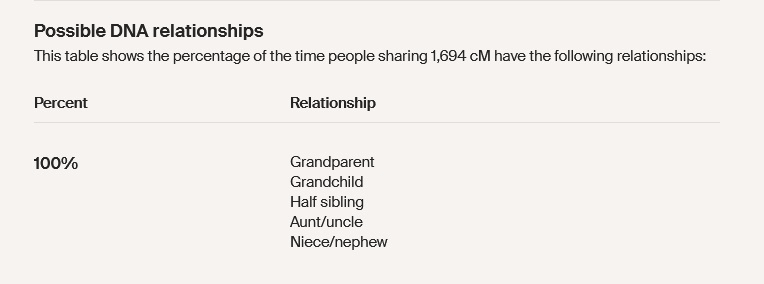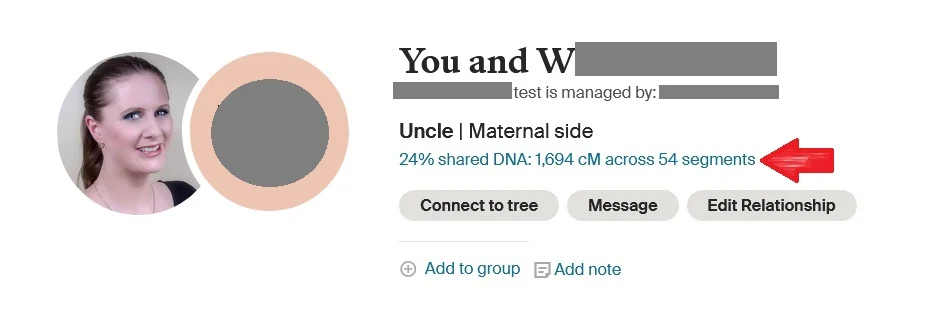Do you have a 100% DNA match on your Ancestry results? In this post, learn what it means to match someone at 100% and how to understand these results.
Over the past few months, I have a received several e-mails asking about their "100%" matches on Ancestry. In addition, I've gotten a few questions from readers wondering about their matches that are less than 100%.

Since the people on our DNA match lists are almost certainly related to us, it is understandable that we want to closely examine the nature of our shared DNA. We can use this information to find out whether we are biologically related to our known relatives in the way that we grew up thinking they were, and to determine where newly discovered relatives fit into our family tree.
What does it mean to have a 100% DNA match on Ancestry?
A 100% DNA match on Ancestry means that your relationship to your relative is almost certainly one of the relationships listed in the relationship column. We will typically only have 100% probability DNA matches for relatives who are either descended from us, or very closely related.
As you may have noticed, I used the word "probability". The correct way to read the chart that is displayed is that there is a "100% probability of the DNA tester and the DNA match having one of the relationships listed in the relationship column".
The 100% number does not mean that we share 100% of our DNA with our match.
The image below is an example from the possible DNA relationships listed for a "100% DNA match" between myself and a paternal uncle. We share 1694 centimorgans, and have a 100% probability of having the one of the relationships listed, which include grandparent, grandchild, aunt/uncle, half-sibling, or niece/nephew.

The way to understand this is to know that the amount of DNA shared, which is in my case 1694 cMs, is within the typical range of shared DNA for relationships that are listed. For every type of relationship, we expect to see the amount of shared DNA fall into a typical range.
These ranges can help us estimate how we are related to our match and figure out if we share the correct amount of DNA with known relatives.
How to find this information
If you have never seen this information on your DNA match list before, you can easily access it by clicking on one of your DNA matches from the main screen of your DNA match list. Then, click on the blue link that displays the percentage of DNA you share with your match.
The image below shows a red arrow that points to where you should click to access this information. On my example, you see that I share 24% of my DNA with my maternal uncle that equals 1694 cMs across 54 DNA segments.

Once you click the link, a pop-up will appear that will provide you with additional information about your relationship to the DNA match. This information will include details about the probabilities of your relationship falling into particular categories of relationships, as well as information about the longest segment and unweighted segment, which I also find very interesting.
Does matching less than 100% mean a different relationship?
Showing a less than 100% probability of sharing any of the relationships on the list does not mean that you are not related in the way that you think you are. It also does not mean that you are not really related, or are less related, to your DNA match.
As I mentioned earlier in this article, we will typically only show the 100% probability of a group of relationships if we are closely related to a DNA match. This is because it is usually impossible to estimate with 100% certainly our relationship to someone using only the amount of shared DNA.
For every type of family relationship, there is a range of shared DNA that we expect to see. For close relationships, such as uncle, grandparent, or sibling, there is less overlap with ranges seen for other relationships.
For example, we know that full siblings typically share at least 2300 centimorgans of DNA. If you share 2800 cMs with your sibling, there is no other family relationship that shares that level of DNA, which would lead to a 100% probability that your match is a full sibling.
However, if you have a half-sibling with whom you share about 1350 cMs, you might not see any category with relationships listed at 100% probability. This is because it is also possible for other relatives, such as first cousins, to share 1350 cMs of DNA with us.
If we know how we are related to our DNA match and our known relationship is listed in the relationship possibilities, even if the probability is lower than we think it should be, we don't need to worry. This is absolutely normal and expected when researching DNA matches.
If we don't already know how our DNA match is related, it can be confusing to have multiple categories with different probabilities. We have to have other information to be able to figure out how we are related.
How to know which relationship your 100% match is?
If you have a 100% match that falls into a category with multiple relationship possibilities, such as the example that I used in this article, there are steps you can take to figure out exactly which relationship applies to your DNA match.
Check out your shared matches
One of the most helpful ways to eliminate possibilities of how your "100%" DNA match is related to you is to research your shared DNA matches. This can help you discover if your DNA match is descended from you, if they are your direct ancestor (in the case of a grandparent match), or if they are descended from one or both of your parents.
For example, a person who is descended from you will share close matches in common with you who are related to you on both sides of your family. If you have maternal and paternal first cousins who have tested on Ancestry, as an example, then a DNA match descended from you will shared these DNA matches in common.
Find out how much they share with other relatives
If you have other relatives who have taken DNA tests, you could find out how much the match shares with them. This, along with their shared matches, could provide some clues and possibly eliminate some relationship possibilities.
Examine your matches age
If your DNA match is not old or young enough to have a particular relationship with you, you can use this information to eliminate it from the list of relationship possibilities.
Find out where your match lives
Similarly, finding out the city or state, or possibly even country, where your DNA match lives or was born can sometimes provide clues about who their parents might be. This could help you figure out where they fit in your family tree, especially since they are likely to be a fairly close relative.
This is the way that I was able to determine my mother's relationship to a close cousin match. The cousin was born in another country where one of my mother's relatives had been stationed in the military.
Conclusion
I hope that this post has helped you understand what it means to see this "100%" number on your Ancestry DNA match. This information is very helpful and can be useful in researching our DNA matches.
If you have any question about something that you read in this article, or if you have a specific question about the relationship possibilities you see on your 100% match list, please feel free to join in the discussion below.
Thanks for stopping by today!
